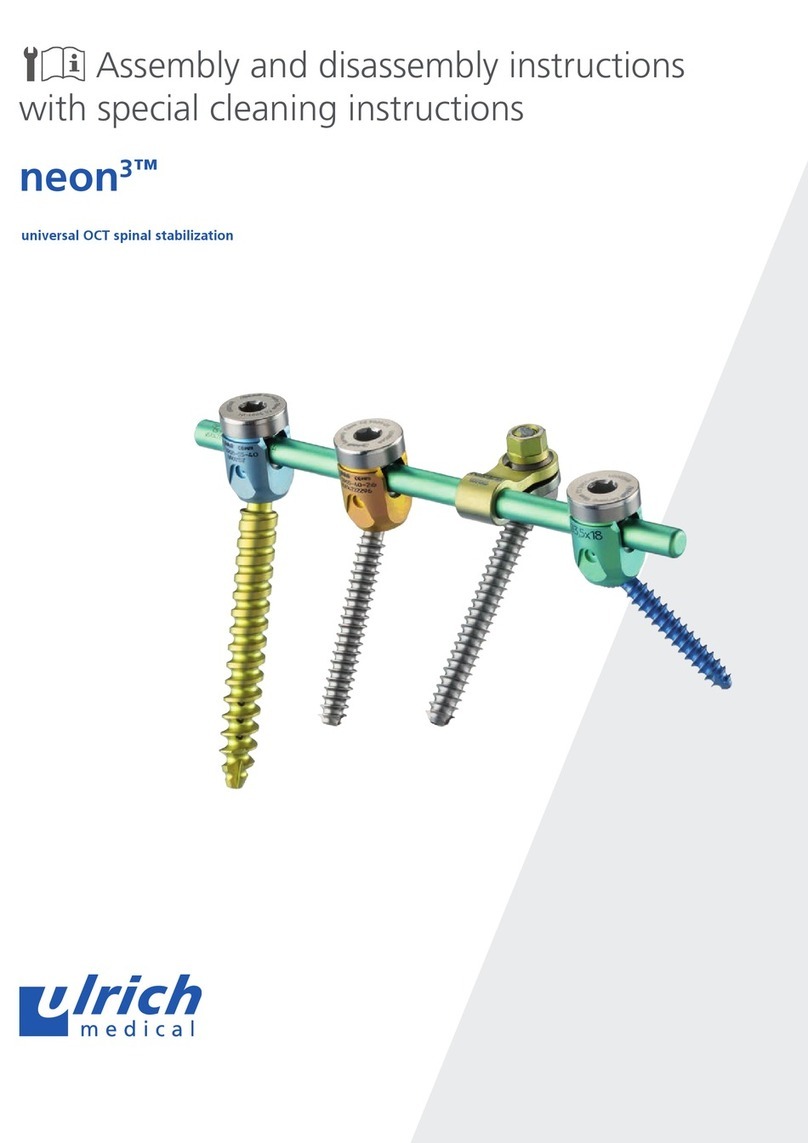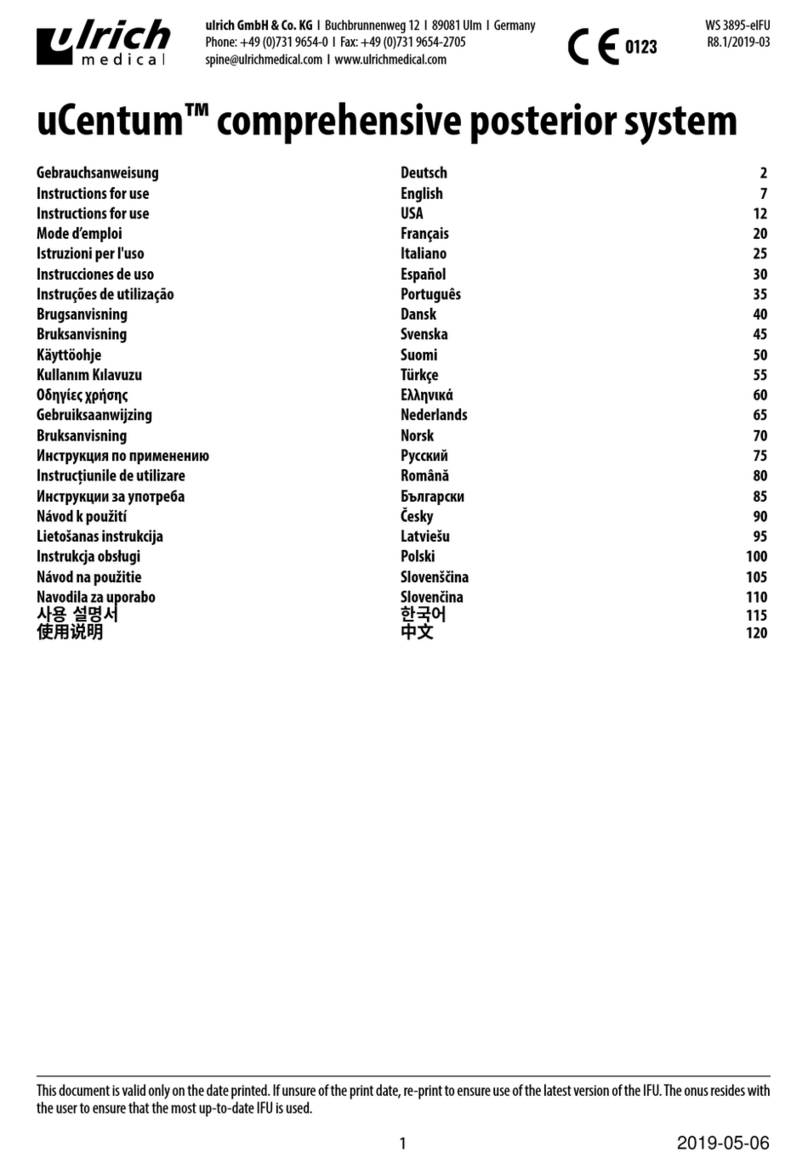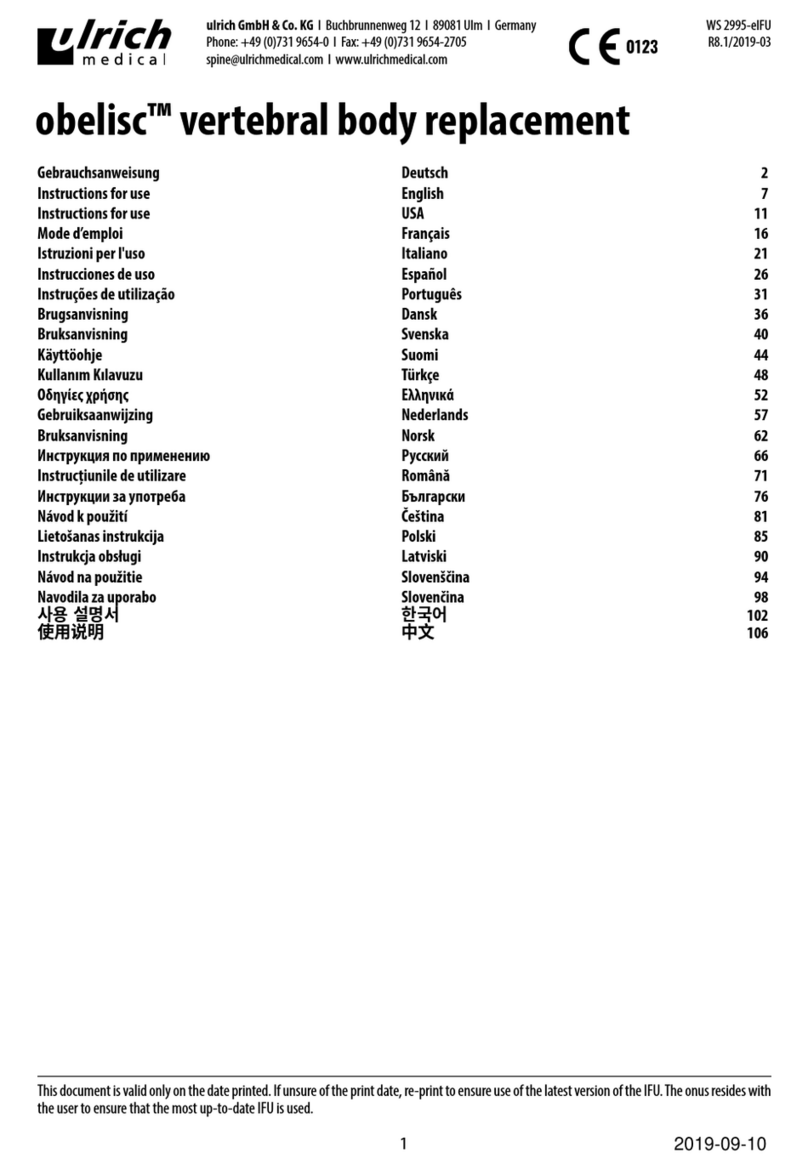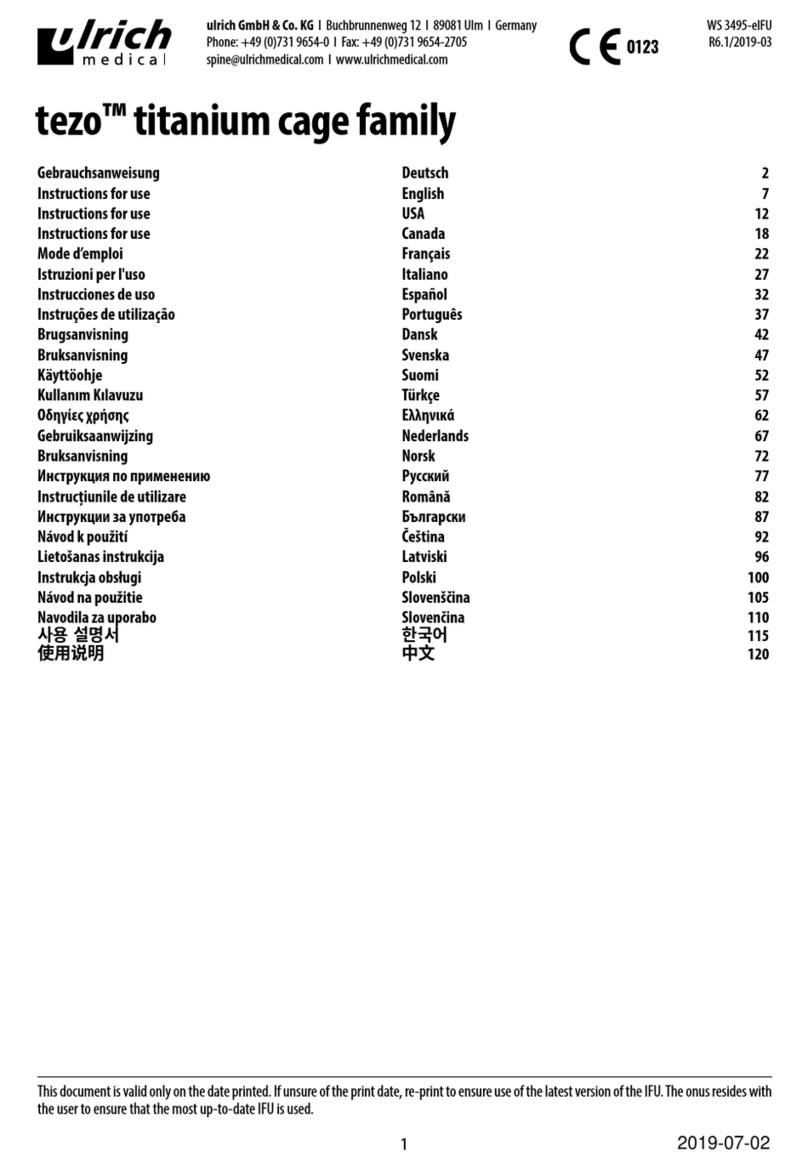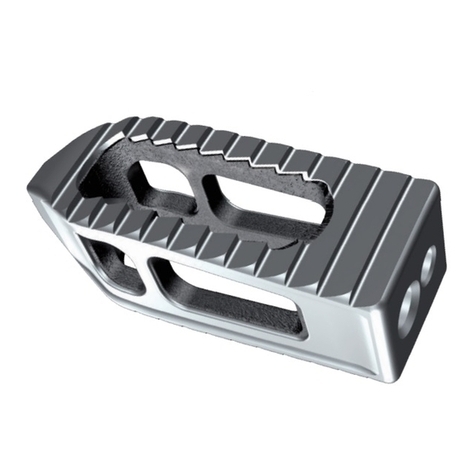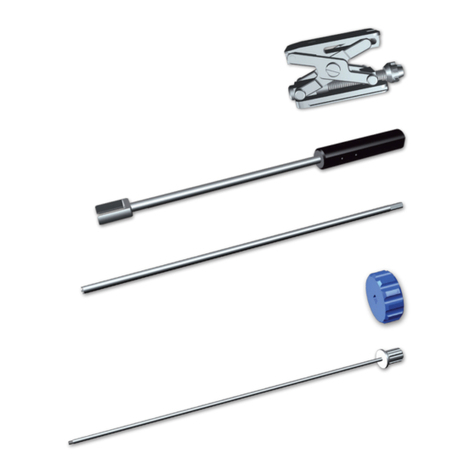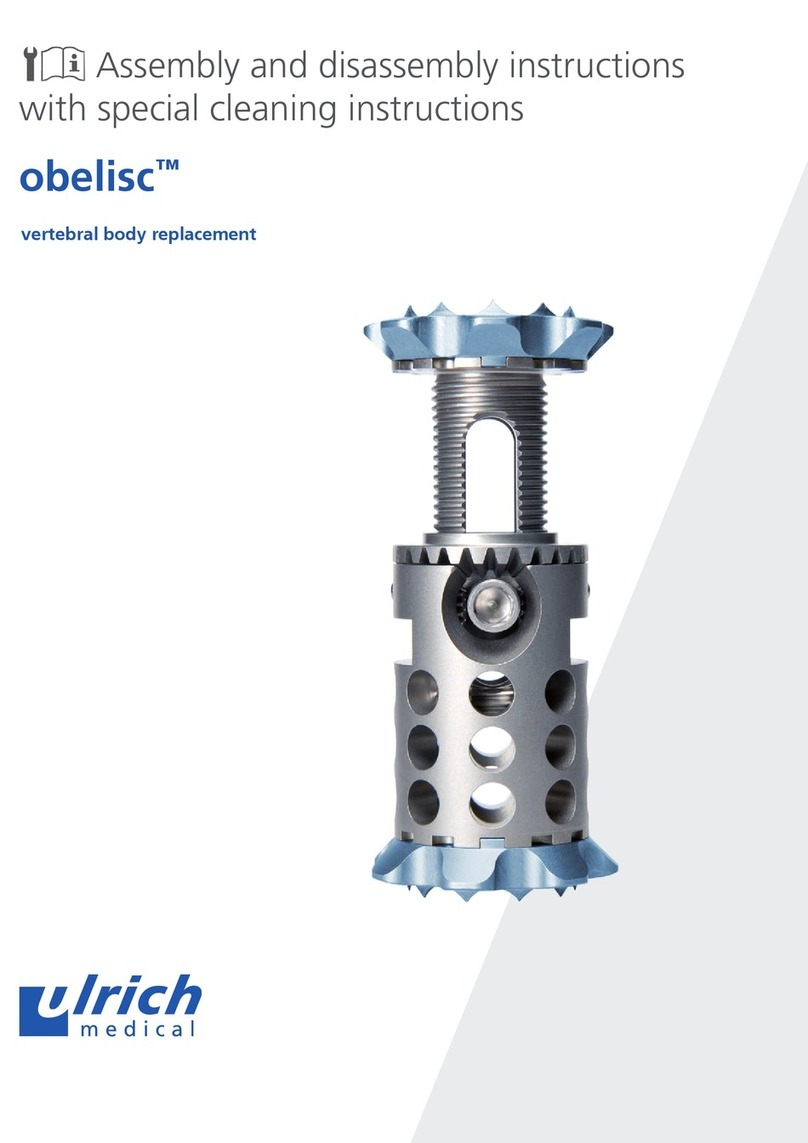
5
Thisdocument is valid onlyon the dateprinted.Ifunsureof the print date,re-print to ensure use of the latestversionof the IFU.Theonusresideswith
the user to ensure that the most up-to-date IFU is used.
REINIGUNG, DESINFEKTION UND STERILISATION
!Allgemeine Informationen
Für die Reinigung, Desinfektion und Sterilisation von unsterilen Implantaten und Instrumenten verweisen wir auf: UH 1100„Aufbereitungs-
handbuch Implantate und Instrumente“. Für einzelne Instrumente, die in der systembezogenen OP-Technik entsprechend markiert sind ( !),
verweisen wir auf die„Montage- und Demontageanleitung mit besonderen Reinigungshinweisen“.
Diese können Sie jederzeit kostenfrei herunterladen unter: www.ifu.ulrichmedical.com
Grundlagen
Unsterile Implantate müssen vor der Anwendung gereinigt, desinziert und sterilisiert werden (Reinigung und Desinfektion nach Entfernen
der Transportschutzverpackung und Sterilisation nach Verpackung). Implantate, die bereits Kontakt mit einem Patienten hatten oder ver-
schmutzt wurden, dürfen unter keinen Umständen erneut verwendet werden, sondern müssen entsorgt werden.
Vorbehandlung
Reinigen/desinzieren Sie Implantate, die Sie berührt haben, sortieren sie diese anschließend wieder in die Implantatlagerung und sterilisie-
ren Sie dann die vollständig bestückte Implantatlagerung. Reinigen Sie alle Implantate, Implantatlagerungen und Sterilisationscontainer nie
mit Metallbürsten oder Stahlwolle. An Implantaten dürfen keinesfalls Öle oder Fette angewandt werden. Bitte beachten Sie zusätzlich die in
Ihrem Land gültigen Rechtsvorschriften sowie die Hygienevorschriften der Arztpraxis bzw. des Krankenhauses.
Reinigung und Desinfektion
Für die Reinigung und Desinfektion der Implantate sollte nach Möglichkeit ein maschinelles Verfahren (Desinfektor) eingesetzt werden. Ein
manuelles Verfahren – auch unterVerwendung eines Ultraschallbads – sollte aufgrund der deutlich geringerenWirksamkeit nur bei Nichtver-
fügbarkeit eines maschinellen Verfahrens eingesetzt werden. Zur Reinigung/Desinfektion müssen die Implantate aus den Sterilisationstrays
entnommen werden.
Manuelle Reinigung/Desinfektion
Bei der Auswahl der eingesetzten Reinigungs- und Desinfektionsmittel ist darauf zu achten,
dass diese grundsätzlich für die Reinigung bzw. Desinfektion der Implantate geeignet sind,
dass das Reinigungsmittel – falls anwendbar - für die Ultraschallreinigung der Implantate geeignet ist (keine Schaumbildung)
dassein Desinfektionsmittelmit geprüfterWirksamkeit (z.B.VAH/DGHM-oder FDA-Zulassungbzw.CE-Kennzeichnung)eingesetztwirdund
dass dieses mit dem eingesetzten Reinigungsmittel kompatibel ist und
dass die eingesetzten Chemikalien mit den Implantaten kompatibel sind (siehe Kapitel„Materialbeständigkeit“)
dass kombinierte Reinigungs/Desinfektionsmittel nach Möglichkeit nicht eingesetzt werden sollten
Maschinelle Reinigung/Desinfektion
Bei der Auswahl des Desinfektors ist darauf zu achten,
dass der Desinfektor grundsätzlich eine geprüfte Wirksamkeit besitzt (z.B. VAH/DGHM- oder FDA-Zulassung bzw. CE-Kennzeichnung ent-
sprechend DIN EN ISO 15883),
dass nach Möglichkeit ein geprüftes Programm zur thermischen Desinfektion (A0-Wert > 3000, alternativ bei älteren Geräten mind. 10 min
bei 93°C) eingesetzt wird (bei chemischer Desinfektion Gefahr von Desinfektionsmittelrückständen auf den Implantaten),
dass das eingesetzte Programm für die Implantate geeignet ist und ausreichende Spülzyklen enthält,
dass zum Nachspülen nur steriles oder keimarmes (max. 10 Keime/ml) sowie endotoxinarmes (max. 0,25 Endotoxineinheiten/ml) Wasser
(z.B. Aqua puricata/Aqua puricata valde) eingesetzt wird,
dass die zum Trocknen eingesetzte Luft geltert wird und
dass der Desinfektor regelmäßig gewartet und überprüft wird.
Bei der Auswahl des eingesetzten Reinigungsmittelsystems ist darauf zu achten,
dass dieses grundsätzlich für die Reinigung der Implantate geeignet ist,
dass – sofern keine thermische Desinfektion eingesetzt wird – zusätzlich ein geeignetes Desinfektionsmittel mit geprüfter Wirksamkeit
(z.B.VAH/DGHM- oder FDA-Zulassung bzw. CE-Kennzeichnung) eingesetzt wird und dass dieses mit dem eingesetzten Reinigungsmittel
kompatibel ist,
dass die vom Hersteller angegebenen Konzentrationen des Reinigungs- und ggf. Desinfektionsmittels unbedingt eingehalten werden.
Kontrolle
Prüfen Sie alle Implantate auf Beschädigungen undVerschmutzungen und sondern Sie beschädigte und verschmutzte Implantate aus.
Verpackung
Benutzen Sie die vorgesehene Implantatlagerung oder eine geeignete Sterilisationsverpackung (EN ISO 11607 / EN 868-2f).
Sterilisation
Das Blitzsterilisationsverfahren ist grundsätzlich nicht zulässig.Verwenden Sie außerdem keine Heissluftsterilisation und keine Strahlens-
terilisation.
Alle Implantate, Implantatlagerungen und Sterilisationscontainer dürfen nur Temperaturen unter 141°C ausgesetzt werden!
Nach der Sterilisation müssen die Implantate in der Sterilisationsverpackung trocken und staubfrei gelagert werden.
